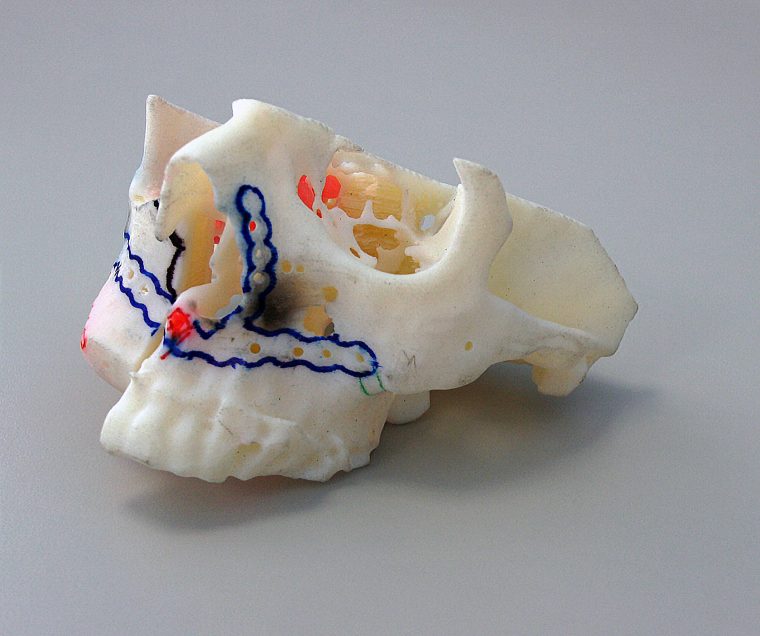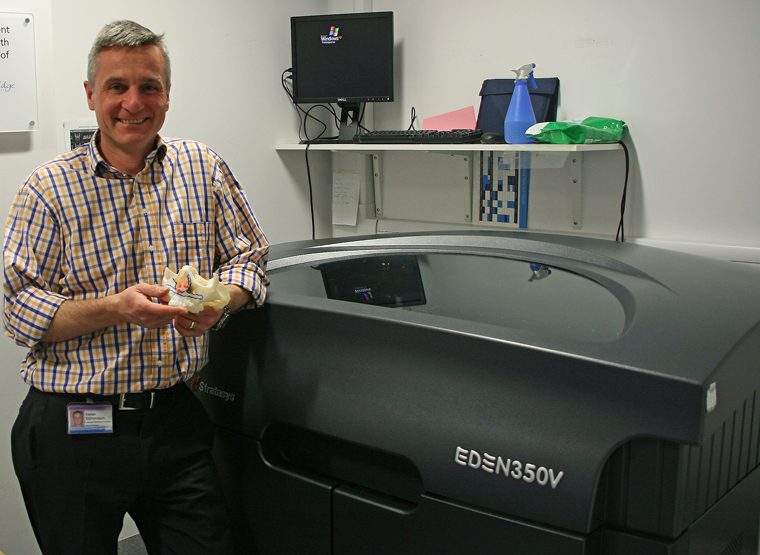As humans, our faces are very important to us. I’m not talking about in a physical sense, although that is certainly true as well, but in terms of how they form and are formed by our identities. Having a damaged or deformed face can be profoundly disturbing to its owner, even if the facial difference doesn’t cause any physical difficulties, especially in childhood as children are forming their identities and so often wish to be like others.
The surgeons in the Maxiollfacial surgery unit at Queen Elizabeth Hospital in Birmingham, UK are dedicated to repairing facial anomalies to the greatest extent possible. Most of the patients undergoing surgical treatment there are undergoing procedures that are a result of trauma or cancer, particularly facial and cranial tumors. The benefits of 3D printing technology have not been lost on the staff and they have, for some time, been utilizing 3D printing to create models for both the preparation for and execution of complex surgical interventions. As Stefan Edmondson, Consulting Maxillofacial Prosthetist at the hospital explained:The in-house Stratasys 3D Printer enables the creation of exact replicas of the patient’s anatomy and allows customized fittings and pre-bending of plates
“When dealing with severe cases whereby surgical plates hold facial bones in place, we need absolute assurance that they fit the patients’ measurements exactly. 3D printing a replica of the patient’s anatomy allows us to pre-bend these plates in our laboratory. Having these capabilities at the hospital streamlines the entire operation and ensures we are 100 percent prepared when heading into surgery.”
As a result of the continuing and demonstrable positive results achieved through the utilization of this advanced technology, the hospital has decided to invest in in-house 3D printing capabilities. The hospital is working with Stratasys to set up the PolyJet printing capabilities and expects to see significant savings both in terms of money and time. The surgeons currently use 3D printing services to provide them with anatomical models that give them every advantage during the critical time when they are carrying out a procedure, and Edmondson estimates the impacts will be quite significant:
“The ability to produce lifelike medical models in-house on our Stratasys 3D printer saves around three to four hours in OR time per surgery, which at a cost of £5,000 an hour of operating room time, is quite a substantial cost saving…If we need to remove bone from a patient’s face, we can produce an exact 3D printed model to develop the cutting guides. This process results in more efficient clinical outcomes and saves the hospital, patient and medical practitioner valuable time and associated costs.”
 Not only is there a reduction in the amount of time during surgery, but it also speeds up, by as much as 93%, the time associated with planning a surgery as well. In addition, it has been repeatedly demonstrated that reductions in operating time as a result of measures such as these are better for the patient’s recovery. The integration of the Objet Eden350V 3D printer is less of a surprising development and more of a reaffirmation of what is becoming a generally accepted tool to benefit both surgeons and patients.
Not only is there a reduction in the amount of time during surgery, but it also speeds up, by as much as 93%, the time associated with planning a surgery as well. In addition, it has been repeatedly demonstrated that reductions in operating time as a result of measures such as these are better for the patient’s recovery. The integration of the Objet Eden350V 3D printer is less of a surprising development and more of a reaffirmation of what is becoming a generally accepted tool to benefit both surgeons and patients.
The more often 3D printing is used in surgery, the better understood its role in advancing surgical outcomes becomes. In addition, the more opportunities that are had to utilize the technology, the farther the boundaries of current understanding of how it can be used are pushed. As Scott Rader, Stratasys’ General Manager of Healthcare Solutions asserts:
“The advances Queen Elizabeth Hospital is making in the use of 3D printing in surgical planning are remarkable. It is a clear demonstration of the ability for 3D printing to enable physicians to better plan, practice and determine the optimal surgical approach. In the current operating climate, physicians need solutions that can save time and money, while also improving quality of care. Queen Elizabeth’s implementation of 3D printing achieves these goals.”
While the initial dream of 3D printing enthusiasts might have been a printer in every home, ready to create anything we need at the touch of button, the real on the ground impacts are now in the form of lives changed through the studied integration of 3D printing technology into medicine. A 3D printer in every hospital is becoming the new normal. And this is still just the beginning. Discuss in the Queen Elizabeth forum at 3DPB.com.
Subscribe to Our Email Newsletter
Stay up-to-date on all the latest news from the 3D printing industry and receive information and offers from third party vendors.
Print Services
Upload your 3D Models and get them printed quickly and efficiently.
You May Also Like
Heating Up: 3D Systems’ Scott Green Discusses 3D Printing’s Potential in the Data Center Industry
The relentless rise of NVIDIA, the steadily increasing pledges of major private and public investments in national infrastructure projects around the world, and the general cultural obsession with AI have...
3DPOD 260: John Hart on VulcanForms, MIT, Desktop Metal and More
John Hart is a Professor at MIT; he´s also the director of the Laboratory for Manufacturing and Productivity as well as the director of the Center for Advanced Production Technologies....
Etsy Design Rule Change Reduces Selection of 3D Printed Goods
Online marketplace Etsy has implemented a rule change requiring all 3D printed goods on the site to be original designs. The update to the site’s Creativity Standards states, ¨Items produced using...
E-Beam OEM Wayland Additive Partners with USC Racing to 3D Print Titanium Exhaust Collector
Every year, standards organization SAE International holds a competition called Formula SAE, in which students from both undergraduate and graduate programs design, build, and race small formula-style race cars. For...



































